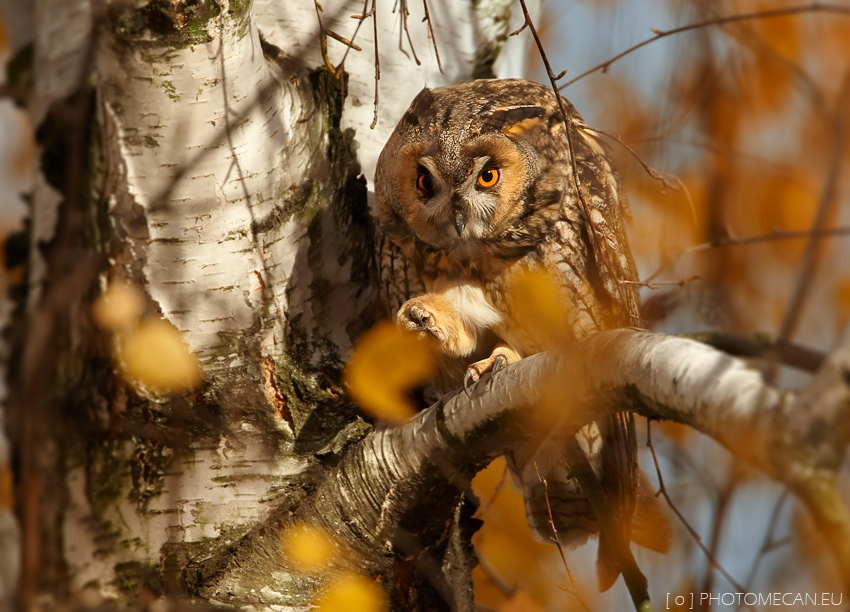
By Megan Lock, GWCT Advisor
Over the last few months, I have heard more and more about an owl that I have never seen, so it has become my latest quest to catch sight of our elusive long-eared owl (Asio otus). Said to be our most nocturnal owl, the long-eared owl is seldomly seen hunting during daylight hours.
The long-eared owl has mottled orange-brown feathers, distinct white eyebrows and striking orange eyes. It has large ‘ear tufts’, which are normally flattened but become raised when the owl is alarmed.
They are most commonly confused with the short-eared owl, as they can look very similar when their tufts are flattened, but the best way to separate these species is when the long-eared owl is perched. Generally the ear tufts will be visible or, if you get a good look at the owl, the eye colour gives clear indication of species: those of long-eared owl are yellow-orange, while in short-eared owl they are yellow.
I always thought the long-eared owl to be larger than it actually is, but it is a medium-sized owl, slightly smaller and slimmer in appearance than a tawny owl, with a wingspan of 95cm, weighing 290g and total length of 35-37cm. It looks deceptively long and thin when in flight but is actually no bigger than a woodpigeon. Despite being called the ‘long-eared’ owl, the tufts on its head aren’t ears at all; they are simply used to make it look bigger!
The call of the tawny and the screech of the barn owl are well known, but I was recently told that the best way to describe the territorial call of the male is to remember the of the sound made when blowing across the top of a milk-bottle – a soft “hoo”. Although this call can be far carrying, it can be difficult to pick out at a distance. I must admit, I have thought I have heard one once as it was different to other owls, but because the call be so low and quiet, I was never quite sure! However, the young long-eared owl calls are very distinctive, using a sharp, squeaking whistle call, reminiscent of a squeaky gate.
So where do you find these owls? They are most associated with coniferous woodland, hedgerows, shrubby thickets and preferring tall scrubby habitats during the breeding season, favouring sites where dense nesting cover is located close to open areas that are used for hunting.
Long-eared owls advertise their occupancy of a territory from late January, with a peak in calling behaviour during February and early March, when displaying individual males bring their wings together during flight to generate a soft clapping sound. Although UK breeders may retain a territory throughout the year, they usually occupy a new nest site each season, typically situated within a short distance of the one used the previous year.
The long-eared owl is extremely elusive during the breeding season, which takes place from February/March onwards. They tend to nest in conifer trees, generally rearing young in the disused nests of other birds (often crow or magpie), and may occasionally nest on the ground at the base of a tree or under a bush. They are also known to use tree hollows and artificial nesting baskets, and lay a clutch of three to five eggs, which hatch after around 25–30 days. The chicks are then ready to fledge 30 days after hatching, but they will still need to be fed by their parents for up to two months.
Although the long-eared owl is widely distributed across the UK (with fewer birds in Wales and the south west), it remains a scarce breeding species and one that is easy to overlook. It also appears on the Green List of Birds of Conservation Concern, but there isn’t enough known about its populations to determine how they are faring. The most recent population estimates suggest a UK breeding population numbering between 1,100 and 3,600 pairs. But it is thought that the species may be in decline in some areas, with changing habitat quality and increased competition from tawny owl impacting on the species, which might be a reason why it appears to be more abundant in Ireland than it is within Britain, perhaps because of reduced competition from tawny owl, which is absent from Ireland.
So, listen out for the low sombre “hoo”, clapping wings of males displaying, and squeaky gate calls in the next few months if you are out at night. You might be lucky enough to catch a glimpse of our native elusive orange-eyed long-eared owl.
